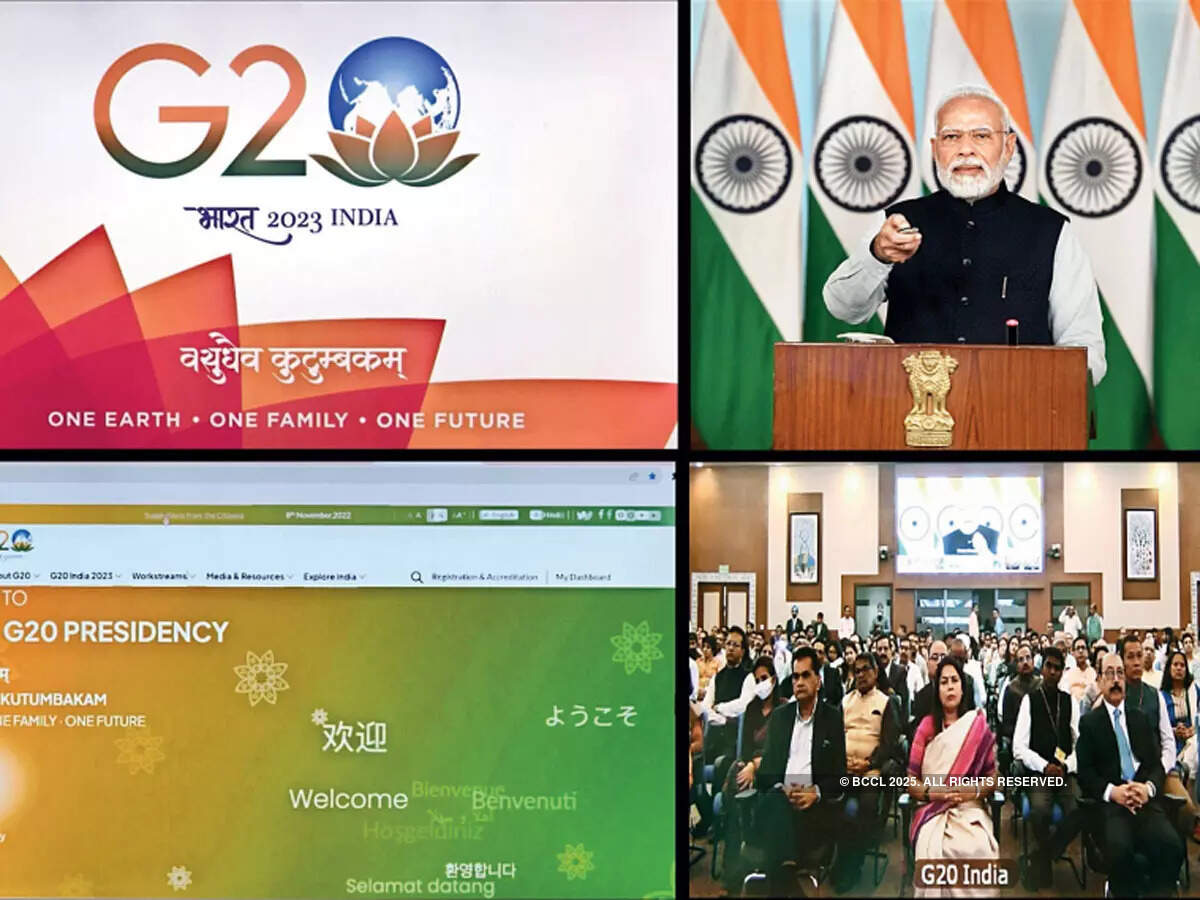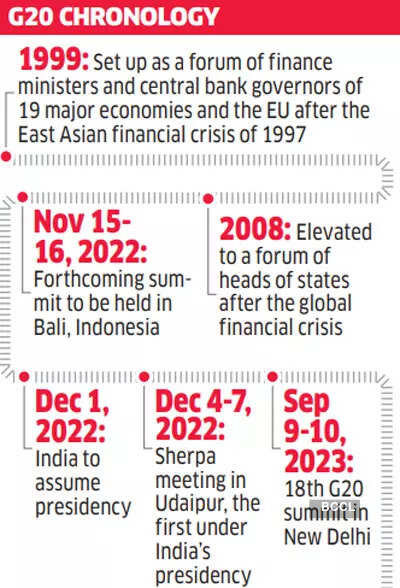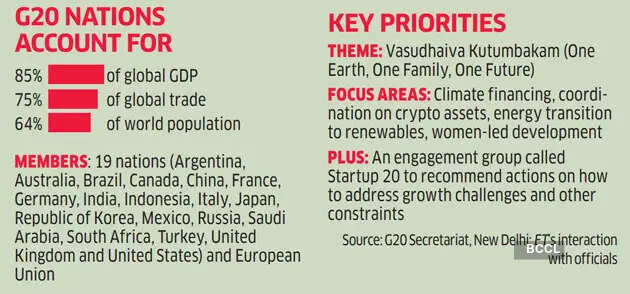
On December 1, India will take over the mantle of G20 presidency. It’s a significant moment as it offers New Delhi the opportunity to anchor a powerful global bloc that comprises both elites and emerging nations. In a fractured and crises-laden world, a neutral India — which remains equidistant from the West and Russia in the ongoing war in Ukraine — could take everyone along when it hosts the summit on September 9-10, 2023. India will have a yearlong presidency till November 30 next year.
Fissures in the bloc are clearly visible as Indonesia’s resort island of Bali gets ready to host this year’s G20 summit on November 15-16. The West and Russia have refused to see eye to eye; they were reluctant even to sit together and sort out issues during the run-up. Russia has announced that President Vladimir Putin will skip the summit.
G20 comprises 19 nations (Argentina, Australia, Brazil, Canada, China, France, Germany, India, Indonesia, Italy, Japan, Republic of Korea, Mexico, Russia, Saudi Arabia, South Africa, Turkey, United Kingdom and United States) plus the European Union. Its influence emanates from three vital statistics — it contributes 85% to the global Gross Domestic Product (GDP) and 75% to world trade, and houses 64% of the world’s population.
 Talking to ET, India’s G20 sherpa, Amitabh Kant, says New Delhi is hopeful of a robust coordination during its presidency. “India’s view is clear — issues of war and conflict need to be discussed in the UN Security Council. G20 is a forum for driving consensus on development, growth and financial issues,” he says.
Talking to ET, India’s G20 sherpa, Amitabh Kant, says New Delhi is hopeful of a robust coordination during its presidency. “India’s view is clear — issues of war and conflict need to be discussed in the UN Security Council. G20 is a forum for driving consensus on development, growth and financial issues,” he says.
So, what is the blueprint for India’s presidency? New Delhi has not published any such strategy paper as yet. But based on available documents, speeches and ET’s interactions with half a dozen people privy to the roadmap, it is apparent that the blueprint will encompass novel ideas as well as some elements of continuity from Bali.
On the financial front, India’s priorities may include climate financing, global coordination on crypto assets, conclusion of international tax reforms and the catalysing of private capital flows.
“There will be some continuation on the finance track. But on the sherpa track, we will take some liberty to take things forward in an innovative way,” says Kant. “We will create a new narrative. Till now India was reacting to the agenda prepared by the developed world. The G20 presidency will enable us to drive a global agenda for the first time.”
THREE TRACKS
According to the norms of the grouping, as the yearlong countdown to the next G20 summit begins, preliminary discussions are held through three distinct tracks.
First, there is the sherpa track where emissaries, who represent heads of state, call the shots and feed into the decision-making process. Under India’s presidency, 13 working groups, covering areas such as agriculture, digital economy, employment, health and tourism, will work through the sherpa track. Each working group will comprise experts and ministers concerned. The first meeting of the track under India’s presidency will be held in Rajasthan’s Udaipur on December 4-7 — just days after India assumes the leadership role. The following meeting in the sherpa track will be held in Mumbai in mid-December.

The second work stream is called the finance track, which is spearheaded by finance ministers and central bank governors of member states. The eight working groups in this track will discuss issues such as international financial architecture, taxation, and finance and health. One of the groups called the framework working group (FWG), which will discuss global macroeconomic issues of current relevance, is co-chaired by India and the UK. The first meeting of the finance track will be held in Mumbai on December 13-15. Some of the other venues for deliberations through the finance track include Kolkata and Pune. The first meeting of the joint finance and health task force is scheduled to take place virtually on December 19.
The third work stream that will meet regularly ahead of the summit is called engagement groups. While many groups such as Business 20, Civil 20, Labour 20, Science 20 and Think 20 will be a continuation from the past, India’s presidency will add a new group called Startup 20, which in turn will recommend actions to G20 leaders on how to address growth challenges and other constraints. Some of the engagement groups in the past helped synthesise recommendations into policy briefs. For example, Think 20, called T20, has brought together various think tanks, effectively serving as an “idea bank” for G20. It was initiated by the Mexican presidency in 2012.
G20 was established as a forum of finance ministers and central bank governors of large economies in the aftermath of the East Asian financial crisis of 1997. It took more than a decade and another devastating financial crisis (2008) to get itself elevated as a forum of heads of states. Under India’s presidency, there will be 43 countries and multilateral bodies — 20 members, 9 guest countries (India has invited Bangladesh as a guest) and 14 multilateral bodies (the International Solar Alliance, Coalition for Disaster Resilient Infrastructure and Asian Development Bank have been invited by India). The World Bank, International Monetary Fund, World Trade Organization etc., will continue to take part in the summit and in its run-up.
TREAD CAREFULLY
Sheel Kant Sharma, a former Indian diplomat who had served as secretary general of the South Asian Association for Regional Cooperation (SAARC) in 2008-2011, says India should tread carefully once it assumes presidency. “My own experiences in the SAARC secretariat suggest we should be modest enough and avoid saying that India will now be leading the world. Yes, India is suited well to assume presidency of the G20 at this juncture and also deal with the current polarised world. But we have to be cautious and must not suddenly behave like a big brother.”
Even before India takes charge of the grouping, a row — although political and domestic in nature — erupted when Prime Minister Narendra Modi unveiled the G20 logo which has the lotus, India’s national flower as well as the election symbol of the ruling Bharatiya Janata Party. “No matter how adverse the circumstances, lotus still blooms,” said Modi, a comment seen by his opponents as a subtle political message in this election season. Former Union minister and Congress leader Jairam Ramesh took to social media to slam the act, calling it “a shameless attempt” of self-promotion.
Meanwhile, New Delhi has been readying its proposed narrative ahead of the Bali summit where India’s presidency will be formally announced. The narrative of the presidency could have three important strands, according to sources privy to the matter. One, showcase India in areas where it has made considerable progress — public digital infra, direct benefit transfer, digital health and pharmaceuticals. Two, influence the world on issues that are of particular interest to India — climate financing, energy transition (to renewables) and women-led development. Three, call for multilateral reforms as an agenda under a broad theme called “shape the future”. “Attempts will be made to bring in big private capital for climate financing,” says a source. This will require reforms in multilateral lending bodies which will then have to play the role of a guarantor.
India’s former G20 sherpa, Suresh Prabhu, says India should seriously work on tangible outcomes and leave a legacy. “One of the characteristics of G20 is that it does not have a permanent secretariat. So the institutional memories of G20 are very limited. I feel India should offer a permanent outcome — some sort of an architecture, physical or digital — under which all proceedings of G20 can be documented.”